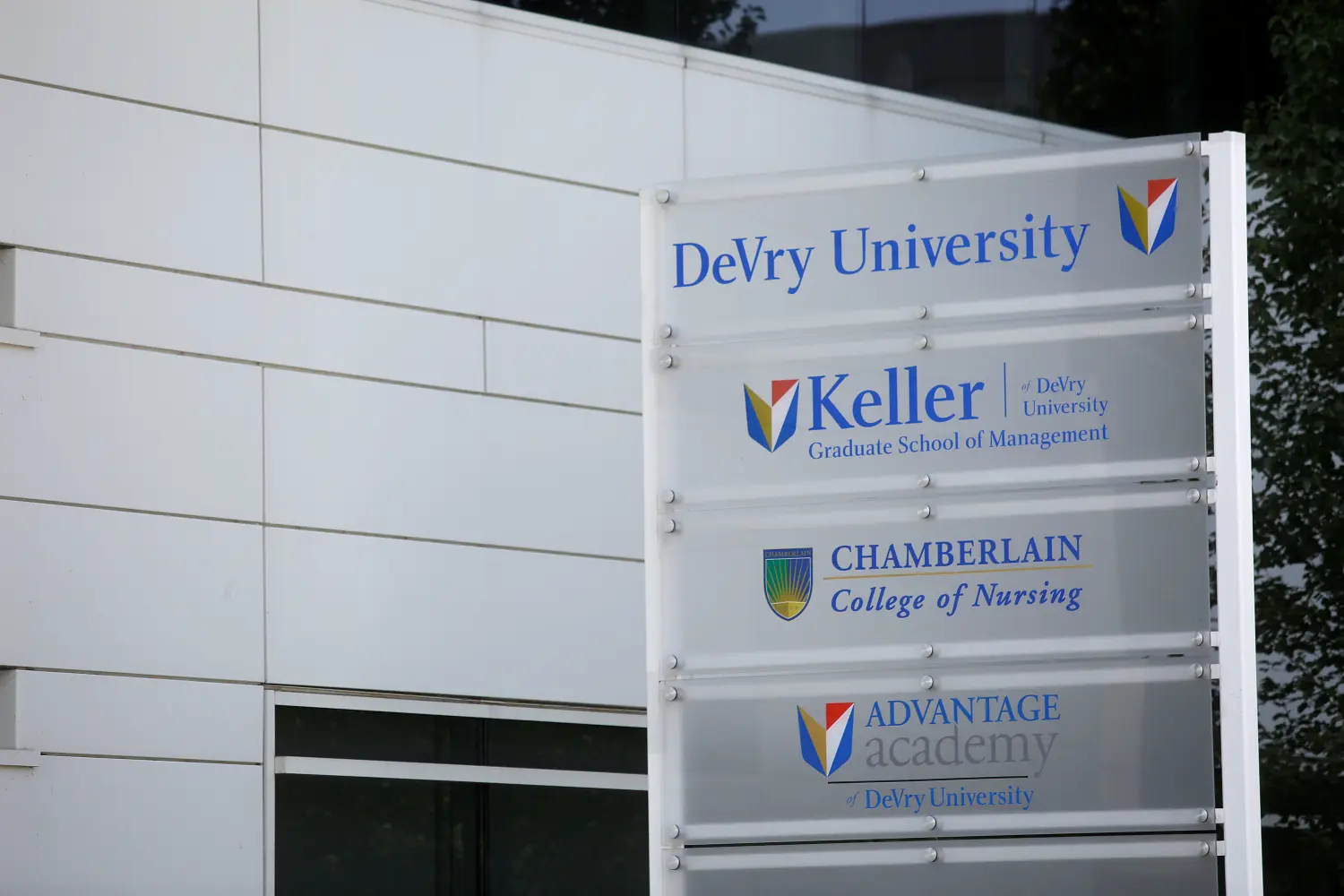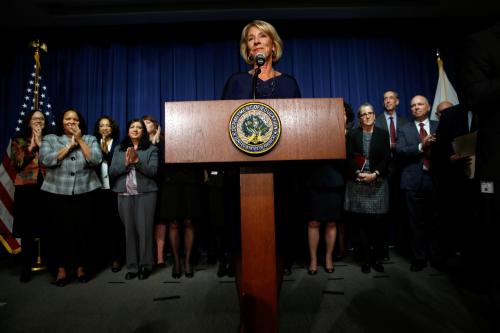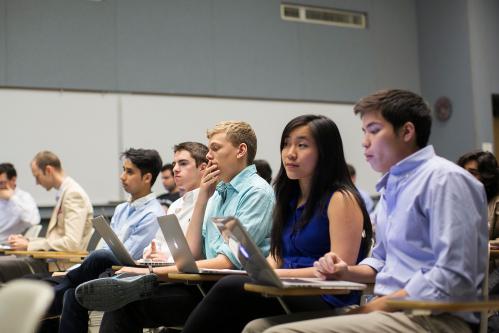In the United States, the barrage of advertising from colleges and universities is unrelenting. Colleges seem to advertise nearly everywhere—on TV, on the internet, and even on subway trains. Commercial advertising is among the most pervasive recruiting tactics used by postsecondary institutions, but we know very little about it. Just how much do colleges spend on advertising? The answer: a lot. In 2017, the most recent year for which data are available, degree-granting U.S. postsecondary institutions spent roughly $730 million on advertising—including TV, cable, outdoor, and online ads.
College advertising spending was even higher just a few years ago. It grew throughout the early 2000s, reached a peak of $1.2 billion in 2013, and has since declined. Trends in advertising spending appear to track patterns of enrollment in for-profit institutions, but with a lag. This correlation is not surprising. As we describe below, for-profit institutions account for the largest share of ad spending, but the smallest share of students: Degree-granting for-profit institutions account for about 40% of all higher education advertising spending, while serving just 6% of students. Among the institutions that advertise, for-profit institutions spend almost $400 on advertising per student, compared to just $48 per student among nonprofits and $14 per student among public institutions. These stark differences by sector remain when we control for other institutional characteristics that may drive advertising spending, such as size, level, chain status, and the percentage of online students.
“Degree-granting for-profit institutions account for about 40% of all higher education advertising spending, while serving just 6% of students.”
These figures—and the others used in this report—are based on calculations of Kantar Media’s “Ad$pender” data, which tracks network TV, cable television, spot television, national magazine, newspaper, outdoor, and internet display ads. Kantar estimates the dollars spent by each firm (in our case, colleges) for advertising in the 100 largest media market areas in the United States.1 Since colleges are not currently required to report advertising expenditures to the Department of Education, these estimates are among the first to assess just how much colleges in the U.S. spend on commercial advertising and how these patterns have changed over time.2
Advertising and policy
Recent policy debates have centered around whether for-profit institutions should face more oversight relative to other institutions due to a business model that may lead them to focus more on enrollments (and therefore profit)—and less on student success. Concerns surrounding very high tuition, high student debt and default rates, and poor earnings outcomes in the sector prompted the 2014 “Gainful Employment” (GE) regulations that required for-profits and non-degree programs in other institutions to meet certain debt-to-earnings thresholds to maintain eligibility for federal student aid. The regulation sparked debates over whether for-profits should face tighter accountability metrics than institutions in other sectors (Cellini et al. 2017, Murakami 2020, Gillen 2020). In 2019, Education Secretary Betsy DeVos repealed the GE regulations, largely justifying the move based on claims that it unfairly singled out the for-profit sector (Federal Register 2019). Similar debates have arisen in the application of and proposed fixes to the so-called “90/10 rule,” which stipulates that proprietary institutions receive no more than 90% of their revenue through federal student aid programs (Looney and Lee 2019).
At the heart of these debates is a question as to whether for-profits behave differently because of their for-profit status and the incentives it creates, or whether differences in behavior are driven by other institutional or student characteristics. We address this question in the context of advertising by controlling for institutional characteristics with regression analysis and find support for the exceptionalism of the for-profit sector.
Policymakers have also raised valid concerns over the lack of transparency in advertising and recruitment in higher education in recent years. Critically, advertising expenditures may be added to a college’s “student services” expenditures in the Department of Education’s annual survey of college finances in the Integrated Postsecondary Education Data System (IPEDS), making assessments of student services—and advertising—nearly impossible to disentangle. We therefore estimate the share of student services expenditures that are likely accounted for by commercial advertising. Among for-profit colleges, we find that advertising expenditures make up over 40% of reported student services spending in the IPEDS data. Among the group of for-profits with over $1 million in ad spending, the average ad spending increases to 85% of reported student services.
“Among the group of for-profits with over $1 million in ad spending, the average ad spending increases to 85% of reported student services.”
Beyond transparency, allegations of false advertising have plagued the for-profit sector. Several high-profile investigations and lawsuits have resulted in large settlements and debt-relief for students who were victims of misrepresentations by institutions such as the (now-shuttered) Corinthian Colleges (U.S. Department of Education 2015), DeVry University (Federal Trade Commission 2016), and most recently the University of Phoenix (Federal Trade Commission 2019). Under the federal government’s ban on misrepresentation and incentive compensation, the Department of Education may withdraw access to federal student aid for institutions that make misrepresentations to students, but analysts suggest a lack of enforcement in recent years (Shireman 2019).
An understanding of commercial advertising in higher education can contribute to our understanding of student enrollment choices, the growth of for-profit and online education, and differences in recruiting practices across institutions and sectors. Further, insights from our analyses can inform policymakers about the potential responses of students and institutions to changes in regulatory policy surrounding student recruitment, information disclosure, and federal student aid. While the Trump administration has eased enforcement of restrictions on advertising and recruiting for for-profit colleges, House Democrats have proposed explicit restrictions on marketing and advertising as a condition of Title IV receipt in their reauthorization of the Higher Education Act (U.S. House Committee on Education and Labor 2019). An understanding of the magnitude and prevalence of college advertising—and differences by sector—is a first step toward assessing the impacts of these policies on institutions, students, and taxpayers.
The growth of college advertising
Figure 1A plots total advertising spending (in constant 2017 dollars) by all degree-granting higher education institutions each year from 2001 to 2017. Spending on advertising increased dramatically over the early 2000s, peaking around $1.2 billion in 2013 before declining in more recent years. As noted earlier, this pattern mirrors enrollment in the for-profit sector—shown in Figure 1B—but with a slight lag. Enrollment more than tripled in the sector between 2000 and 2010, then declined with new regulations and the closure of several large for-profit chains. It seems likely that for-profit institutions may have boosted advertising to counteract the increased scrutiny of the sector between 2010 and 2013, but eventually advertising spending declined as colleges closed.
In Figure 2 below, we look more closely at the different advertising modes or platforms (TV, print, Internet, radio, and outdoor) used by higher education institutions in 2001 and 2017. The upper bar shows the magnitude and distribution of ad spending by mode in 2001. Television advertising makes up the largest share at 46% (roughly $143 million), with print sources next (36%), and internet advertising at 11% of the total. By 2017, internet advertising grew to 16% (and $113 million) as the second-most popular advertising medium, but TV advertising had an even larger share of ad spending at 56% ($413 million). Print declined to 7%, mirroring the general decline in ad expenditures in newspapers and magazines in the 2000s.
In Figure 2 below, we look more closely at the different advertising modes or platforms (TV, print, Internet, radio, and outdoor) used by higher education institutions in 2001 and 2017. The upper bar shows the magnitude and distribution of ad spending by mode in 2001. Television advertising makes up the largest share at 46% (roughly $143 million), with print sources next (36%), and internet advertising at 11% of the total. By 2017, internet advertising grew to 16% (and $113 million) as the second-most popular advertising medium, but TV advertising had an even larger share of ad spending at 56% ($413 million). Print declined to 7%, mirroring the general decline in ad expenditures in newspapers and magazines in the 2000s.
Advertising by sector
Of course, commercial advertising varies substantially across institutions and sectors—with the for-profit sector making up the largest share of expenditures. Breaking down patterns by sector in Figures 3A and 3B highlights the stark differences. In 2014, at the peak of ad spending, for-profit institutions spent over $500 million on ads—more than the total spent by nonprofits and public institutions combined. The sector accounted for 52% of ad spending, while serving just 8% of students. By 2017, for-profit advertising dropped to $275 million—again likely reflecting sanctioning and subsequent closures of several large for-profit chains. Nonetheless, the sector still accounts for about 40% of total ad spending, while serving only about 6% of students (NCES 2018, Table 303.10).
In Figure 2 below, we look more closely at the different advertising modes or platforms (TV, print, Internet, radio, and outdoor) used by higher education institutions in 2001 and 2017. The upper bar shows the magnitude and distribution of ad spending by mode in 2001. Television advertising makes up the largest share at 46% (roughly $143 million), with print sources next (36%), and internet advertising at 11% of the total. By 2017, internet advertising grew to 16% (and $113 million) as the second-most popular advertising medium, but TV advertising had an even larger share of ad spending at 56% ($413 million). Print declined to 7%, mirroring the general decline in ad expenditures in newspapers and magazines in the 2000s.
Advertising by sector
Of course, commercial advertising varies substantially across institutions and sectors—with the for-profit sector making up the largest share of expenditures. Breaking down patterns by sector in Figures 3A and 3B highlights the stark differences. In 2014, at the peak of ad spending, for-profit institutions spent over $500 million on ads—more than the total spent by nonprofits and public institutions combined. The sector accounted for 52% of ad spending, while serving just 8% of students. By 2017, for-profit advertising dropped to $275 million—again likely reflecting sanctioning and subsequent closures of several large for-profit chains. Nonetheless, the sector still accounts for about 40% of total ad spending, while serving only about 6% of students (NCES 2018, Table 303.10).
Perhaps more important than total ad expenditures are ad expenditures per student. Figure 3B shows per-student advertising expenditures over time—the differences by sector are striking. On a per-student basis, for-profit colleges outspend nonprofits more than 4 to 1 and outspend public institutions more than 20 to 1—a pattern that has held steady over time.
In Figure 2 below, we look more closely at the different advertising modes or platforms (TV, print, Internet, radio, and outdoor) used by higher education institutions in 2001 and 2017. The upper bar shows the magnitude and distribution of ad spending by mode in 2001. Television advertising makes up the largest share at 46% (roughly $143 million), with print sources next (36%), and internet advertising at 11% of the total. By 2017, internet advertising grew to 16% (and $113 million) as the second-most popular advertising medium, but TV advertising had an even larger share of ad spending at 56% ($413 million). Print declined to 7%, mirroring the general decline in ad expenditures in newspapers and magazines in the 2000s.
Advertising by sector
Of course, commercial advertising varies substantially across institutions and sectors—with the for-profit sector making up the largest share of expenditures. Breaking down patterns by sector in Figures 3A and 3B highlights the stark differences. In 2014, at the peak of ad spending, for-profit institutions spent over $500 million on ads—more than the total spent by nonprofits and public institutions combined. The sector accounted for 52% of ad spending, while serving just 8% of students. By 2017, for-profit advertising dropped to $275 million—again likely reflecting sanctioning and subsequent closures of several large for-profit chains. Nonetheless, the sector still accounts for about 40% of total ad spending, while serving only about 6% of students (NCES 2018, Table 303.10).
Perhaps more important than total ad expenditures are ad expenditures per student. Figure 3B shows per-student advertising expenditures over time—the differences by sector are striking. On a per-student basis, for-profit colleges outspend nonprofits more than 4 to 1 and outspend public institutions more than 20 to 1—a pattern that has held steady over time.
Institutional averages
Looking more closely at the data, Table 1 shows our most up-to-date 2017 estimates of advertising spending averaged across institutions and split by various characteristics. We focus on institutions that could be matched in the IPEDS and Kantar data, and therefore our estimates represent averages conditional on any commercial advertising over the period we study.3
Table 1: Ad spending by institution type and characteristics, 2017
| Number | Mean ad spending ($000s) | Mean ad spending per student ($) | Ad $ / Student service $ | Ad $ / Total expenditures | |
| (1) | (2) | (3) | (4) | (5) | |
| All institutions | 2,041 | 336 | 53 | 4.3% | 0.3% |
| For-profit | 145 | 1,250 | 371 | 43.4% | 2.0% |
| Nonprofit | 855 | 273 | 48 | 1.8% | 0.2% |
| Public | 1,041 | 171 | 14 | 1.1% | 0.1% |
| Multi-campus chain | 90 | 2,788 | 430 | 37.7% | 2.1% |
| Non-chain | 1,951 | 223 | 36 | 2.8% | 0.2% |
| Online | 65 | 2,883 | 90 | 5.1% | 0.9% |
| Not online | 1,705 | 203 | 36 | 3.4% | 0.2% |
| Four-years or more | 1,489 | 425 | 57 | 4.7% | 0.0% |
| Two-years | 552 | 99 | 43 | 3.1% | 0.3% |
| Enrollment 5,000 or more | 895 | 650 | 28 | 2.6% | 0.2% |
| Enrollment under 5,000 | 1,146 | 92 | 73 | 5.6% | 0.4% |
| Notes: Sample includes degree-granting institutions that appear in both Kantar data (and therefore have non-zero ad spending) and IPEDS. Multi-campus chains are aggregated and subsidiaries are assigned to parent institutions. See data appendix for details. | |||||
In line with the patterns noted earlier for the sector as a whole, institution-level averages show the same pattern: For-profit colleges far outspend institutions in other sectors. On average, for-profit colleges spent $1.25 million on advertising in 2017, as shown in column 2. This exceeds the $273,000 spent by nonprofits and the $171,000 spent by publics. On a per-student basis, the patterns are again quite striking and similar to those found for the sector as a whole: For-profits spent $371 per student on average, compared to just $48 per student for nonprofits and $14 per student for public institutions.4
In the lower rows of columns 2-3, we see that multi-campus chains have much larger advertising budgets than independent institutions ($2.7 million vs. $223,000) and spend much more per student ($430 vs. $36). Online institutions—which we define as having 50% or more of their students taking classes exclusively by distance education—have similarly high overall advertising spending, but much lower per-student spending ($90) than multi-campus chains.5 Four-year colleges spend more than their two-year counterparts and unsurprisingly, larger institutions spend more overall (column 2), but spend less per-student (column 3). Note that each institution appears in each category (e.g., a college may be for-profit, online, multi-campus, four-year, and large); however, within each category, the groups (e.g., for-profit, nonprofit, public) are mutually exclusive. In our data, for-profits are more likely than institutions in other sectors to be online, two-year colleges, and multi-campus chains. They have higher average enrollment than nonprofit institutions (6,500 vs. 4,000), but lower enrollment than public institutions (11,700). We control for these characteristics in our regression analyses below.
“Including advertising in student services gives a faulty impression of spending on student success, and could be misleading for policymakers and students.”
As noted above, postsecondary institutions do not explicitly report advertising expenditures to the federal government in the annual IPEDS survey of college finances. Rather, these expenditures may be listed under the category of “student services” or other areas. Including advertising in student services gives a faulty impression of spending on student success, and could be misleading for policymakers and students. Recent policy proposals have suggested separating advertising and other recruitment expenses from student services (e.g., U.S. House Committee on Education and Labor 2019).
In column 4 we compare ad spending to spending on student services listed in IPEDS. Advertising spending accounts for 43% of student services expenses reported by for-profit institutions, compared to less than 2% for all other sectors. Multi-campus chains (which are predominantly but not exclusively for-profit) have a similarly high percentage (38%), but the average for online institutions is much lower (5%). Relative to total expenditures, advertising expenditures account for about 2% in for-profits, but just 0.2% or less in other sectors (column 5).
Big spenders
While it is clear that for-profit colleges are outspending others, in Table 2 we look more closely at the data to identify the top 10 ad-spending colleges of 2017. Six of the top 10 spenders are large for-profit chains. The top spender, the University of Phoenix outspends its competitors by nearly $25 million. At $76 million spent in 2017, its ad spending has declined considerably since a peak of $142 million in 2013. The two nonprofit colleges in the top 10, Southern New Hampshire University and Western Governors University, are large online colleges that cater to working students and are well-known as competitors of the large for-profit chains. Grand Canyon University, DeVry University, Capella University, Kaplan University (since acquired by Purdue University), and Strayer University represent some of the largest and most well-known for-profits with a large online presence.6
Table 2: Top 10 higher education advertisers, 2017
| Institution | Sector | Total ad spending | Total fall enrollment | Per-student ad spending | |
| 1 | U. of Phoenix | For-profit | $75.9 million | 120,621 | $629 |
| 2 | Southern New Hampshire U. | Nonprofit | $51.4 million | 90,955 | $565 |
| 3 | Grand Canyon U. | For-profit | $28.7 million | 83,284 | $345 |
| 4 | Western Governors U. | Nonprofit | $25.5 million | 98,627 | $259 |
| 5 | DeVry U. | For-profit | $24.7 million | 28,724 | $861 |
| 6 | Capella U. | For-profit | $23.1 million | 36,284 | $637 |
| 7 | Kaplan U. | For-profit | $19.2 million | 38,619 | $496 |
| 8 | Strayer U. | For-profit | $14.0 million | 44,970 | $310 |
| 9 | Pennsylvania State U. | Public | $9.1 million | 93,318 | $98 |
| 10 | U. of Maryland | Public | $8.5 million | 59,379 | $144 |
| Notes: Authors’ estimates of ad spending based on Kantar Media’s “Ad$pender” data and IPEDS fall enrollment data aggregrated at the parent-level for all branches. | |||||
Two public institutions round out the top 10, Penn State and the University of Maryland. Both spend less than $10 million per year and less than $150 per student, far lower than any of the institutions in the top eight spots. Both institutions appear to have invested heavily in online “campuses” in recent years, with Penn State’s World Campus and the University of Maryland’s (recently renamed) Global Campus.
To take a closer look at high-spending colleges, we break our sample into colleges that spent $1 million or more in any year between 2014 and 2017 in Table 3. In the high-spending group, advertising spending averages $5 million, including $9 million among for-profits. Per-student, the high-spending group averages $500 per student, with for-profits more than doubling that average at $1,200 per student. Most striking is that ad spending comprises 85% of student services spending among the high-spending for-profits. Even for for-profits that spend less than $1 million per year, ad spending comprises one-third of student service spending—compared to 3% or less in other sectors.
Table 3: Ad spending for institutions over and under $1 million in ad spending, 2017
| Number | Mean ad spending ($000s) | Mean per-student ad spending ($) | Ad $ / Student service $ | Ad $ / Total expenditures | |
| (1) | (2) | (3) | (4) | (5) | |
| Over $1 million in ad spending | |||||
| All | 96 | 5,033 | 496 | 31% | 3% |
| For-profit | 28 | 9,142 | 1,203 | 85% | 6% |
| Nonprofit | 37 | 4,224 | 287 | 9.9% | 1.4% |
| Public | 31 | 2,288 | 107 | 7.6% | 0.7% |
| Under $1 million in ad spending | |||||
| All | 1,945 | 105 | 31 | 3.0% | 0.2% |
| For-profit | 117 | 160 | 175 | 33% | 1.0% |
| Nonprofit | 818 | 95 | 37 | 1.5% | 0.2% |
| Public | 1,010 | 106 | 11 | 0.9% | 0.1% |
| Notes: Sample includes degree-granting institutions appear in both Kantar data (and therefore have non-zero ad spending) and IPEDS. Multi-campus chains are aggregated and subsidiaries are assigned to parent institutions. See data appendix for details. | |||||
Interestingly, the average spending per-student among for-profits in this table is higher than for the top-10 spenders shown in Table 2. Unlike the large colleges in Table 2, many for-profits spending more than $1 million have small enrollments. If we rank colleges by spending per student rather than total ad spending, seven of the top 10 are for-profit colleges with small enrollments—of these seven, all but two have enrollments below 1,000 students.
For-profit exceptionalism
Recent policy debates around GE regulations and the 90/10 rule—among others—have centered around whether for-profit institutions should face more oversight relative to other institutions due to a business model that may lead them to focus more on enrollments (and therefore profit) and less on student success. A key question is whether for-profits behave differently because of their for-profit status or whether differences in behavior are driven by other institutional characteristics. To shed light on this question, we push further in isolating the correlation between ad spending and sector by running regressions that control for level (four-year vs. two-year), majority of students online, multi-campus chain status, size, as well as changes over time that affect all institutions.7
In Table 4, we show results of our regressions for several different samples of colleges. We begin with the broadest sample of all degree-granting colleges and universities—including those that are not present in the Kantar data and presumably spend $0 on commercial advertising (column 1 and 3). We find large positive associations between for-profit sector and ad spending per student that are significant at the 1% level. In this comprehensive sample, we see that for-profit institutions spend $627,000 more overall and $121 more per student than public colleges. These findings indicate that the patterns of high ad spending by for-profit institutions are not driven by differential selection into our sample of advertising colleges.
Table 4: Regression analyses of college ad spending per student and sector
| Total ad spending (in $000s) | Per-student ad spending ($) | ||||
| All | Advertisers only | All | Advertisers only | ||
| (1) | (2) | (3) | (4) | ||
| For-profit | 627*** | 1,242** | 121*** | 281*** | |
| (223) | (496) | (34) | (75) | ||
| Nonprofit | 146* | 326*** | 29*** | 53*** | |
| (84) | (124) | (6) | (9) | ||
| Covariates | Yes | Yes | Yes | Yes | |
| Year FE | Yes | Yes | Yes | Yes | |
| Observations | 11,185 | 7,206 | 11,179 | 7,200 | |
| R-squared | 0.074 | 0.106 | 0.064 | 0.121 | |
| Notes: *** p<0.01, ** p<0.05, * p<0.1. Covariates include multi-campus chain, online, four-year, and an indicator for enrollment >5000. Standard errors in parentheses clustered at the institutional level. See data appendix for estimation details. | |||||
Conditional on having any advertising spending (columns 2 and 4), for-profits outspend publics by $1.2 million and nearly $300 per student. Importantly, these effects are sizable and significant even when controlling for level, chain, enrollment, and online status, suggesting that the for-profit business model—rather than other institutional characteristics—are at least partially responsible for advertising behavior. We observe much more modest differences in ad spending per student between public and nonprofit colleges across our sample, suggesting that—conditional on any advertising—nonprofits spend about $326,000 more than publics overall and $53 more per student.
Conclusions and policy implications
Advertising spending by U.S. higher education institutions has been volatile in the past decade, roughly matching the growth and decline of enrollment in for-profit colleges. In 2017, U.S. colleges spent over $700 million on commercial advertising, down from a peak of $1.2 billion in 2013. For-profit colleges account for a disproportionate share of this spending: They account for 40% of ad spending while educating 6% of students. They outspend nonprofits 4 to 1 and publics 20 to 1 on a per-student basis. Although some of these raw differences could be due to differences in institutional characteristics, rather than for-profit status per se, our regression analyses suggest that even after controlling for size, level, chain, and online status, large differences by sector remain. For-profits continue to outspend public colleges by about $1.2 million per institution and $280 per student in our regression results.
“The many recent settlements of false advertising cases against high-profile for-profit institutions suggest the need for increased scrutiny of ad content and mechanisms for student reporting of misleading advertising.”
We caution that our estimates are likely an underestimate of total advertising expenditures by U.S. colleges. They are based on Kantar’s estimates of commercial advertising expenditures by degree-granting institutions in only the 100 largest media markets. Further, our estimates do not include the many other forms of recruitment and marketing that colleges undertake to attract prospective students.
Nonetheless, we find that spending on commercial advertising comprises about 43% of reported expenditures on student services for for-profits in IPEDS data and up to 85% for some of the highest spending for-profit institutions. We recommend that policymakers push further in mandating that institutions separately report advertising, recruitment, and marketing in IPEDS to avoid potentially misleading claims of high spending on student services.
Whether college advertising is desirable from a social perspective depends critically on the content of the advertising and the quality of education provided by the advertising college. The many recent settlements of false advertising cases against high-profile for-profit institutions suggest the need for increased scrutiny of ad content and mechanisms for student reporting of misleading advertising. Coupled with this, studies demonstrating negligible earnings gains, disappointing employment outcomes, high default rates, and large debt incurred by students attending for-profit colleges8 suggest the need for further oversight of the sector—both in advertising and in student outcomes. We suggest that policymakers do more to enforce existing laws prohibiting misrepresentation in college advertising and consider taking additional measures to enhance transparency and accountability in the for-profit sector.
References
Cellini, Stephanie Riegg, Adam Looney, David Deming, and Jordan Matsudaira (2017). “Gainful Employment Regulations will Protect Students and Taxpayers. Don’t Change Them.” Brooking Brown Center Chalkboard. August 4, 2017.
Cellini, Stephanie Riegg and Nicholas Turner (2019). “Gainfully Employed? Assessing the Employment and Earnings of For-Profit College Students Using Administrative Data,” Journal of Human Resources, Spring 2019, 54(2): 342-370.
Cellini, Stephanie Riegg and Rajeev Darolia (2017). “High Costs, Low Resources, and Missing Information: Explaining Student Borrowing in the For-Profit Sector,” Annals of the American Academy of Political and Social Science, May, 671(1): 92-112.
Darolia, Rajeev, Corey Koedel, Paco Martorell, Katie Wilson, & Francisco Perez-Arce (2015). “Do Employers Prefer Workers who Attended For-Profit Colleges? Evidence from a Field Experiment.” Journal of Policy Analysis & Management, 34(4): 881-903.
Deming, David. J., Claudia Goldin, and Lawrence F. Katz (2012). “The For-Profit Postsecondary School Sector: Nimble Critters or Agile Predators?” Journal of Economic Perspectives 26(1): 139–164.
Federal Trade Commission (2016). “DeVry University Agrees to $100 Million Settlement with FTC” https://www.ftc.gov/news-events/press-releases/2016/12/devry-university-agrees-100-million-settlement-ftc.
Federal Trade Commission (2019). “FTC Settlement Against University of Phoenix.” https://www.consumer.ftc.gov/blog/2019/12/ftc-settlement-against-university-phoenix.
Gillen, Andrew (2020). “Two Tsunamis are About to Hit Higher Education” Jan. 20, 2020. Texas Public Policy Foundation.
Hall, Stephanie (2019). “How Much Education are Students Getting for their Tuition Dollar?” https://tcf.org/content/report/much-education-students-getting-tuition-dollar/.
Hamilton, Matt. “Corinthian Colleges Must Pay Nearly $1.2 million for false advertising and lending practices” Los Angeles Times. March 23, 2016. https://www.latimes.com/local/lanow/la-me-ln-corinthian-colleges-judgment-false-advertising-20160323-story.html.
Looney, Adam and Constantine Yannelis (2015). “A Crisis in Student Loans? How Changes in the Characteristics of Borrowers and the Institutions they Attended Contributed to Rising Loan Defaults.” Brookings Papers on Economic Activity, Conference Draft, September 10-11.
Looney, A. & V. Lee (2019). Understanding the 90/10 Rule: How reliant are public, private, and for-profit institutions on federal aid. The Brookings Institution, January.
Murakami, Keri. (2020) “Many Nonprofit College Programs Would Fail Gainful Test” Inside Higher Ed. January 16, 2020.
National Center for Education Statistics (NCES) 2018. Digest of Education Statistics. https://nces.ed.gov/programs/digest/d18/tables/dt18_303.10.asp.
Scott-Clayton, Judith. (2018). “The Looming Student Loan Default Crisis Is Worse than We Thought.” Brookings Institution: January 10, 2018. https://brook.gs/2EanLBr.
Shireman, Robert (2019). https://tcf.org/content/report/policies-work-dont-work-stop-predatory-profit-colleges/.
Sweeney, Erica (2019). “Kantar: US ad spend reached $151B in 2018, a 4.1% jump.” Marketingdive.com. Jan. 24, 2019.
U.S. Department of Education (2015) “U.S. Department of Education Fines Corinthian Colleges $30 million for Misrepresentation.” https://www.ed.gov/news/press-releases/us-department-education-fines-corinthian-colleges-30-million-misrepresentation.
U.S. House Committee on Education and Labor (2019). College Affordability Act. HR4674. https://www.congress.gov/bill/116th-congress/house-bill/4674/text.
The Brookings Institution is a nonprofit organization devoted to independent research and policy solutions. Its mission is to conduct high-quality, independent research and, based on that research, to provide innovative, practical recommendations for policymakers and the public. The conclusions and recommendations of any Brookings publication are solely those of its author(s), and do not reflect the views of the Institution, its management, or its other scholars.
-
Footnotes
- See data description in Appendix A for more details. Notably, we focus only on degree-granting institutions in Kantar’s “colleges and universities” category. Our estimate will understate total expenditures in higher education, since vocational institutions are omitted. Future research will explore advertising by non-degree institutions.
- Hall (2019) examines internet advertising by colleges in 2016.
- See data appendix for details on matching. Notably, we can match about 35% of for-profits, 52% of nonprofits, and 65% of public institutions in IPEDS. Multi-campus institutions are aggregated to a single “parent” institution.
- Medians in the for-profit sector are lower than means due to a large number of smaller institutions spending little on advertising (medians are $70,000 in total spending and $89 per student), but patterns across sectors are similar (e.g., median per-student spending in for-profits is more than five times median per-student spending in nonprofits).
- Note that categories are not mutually exclusive, so some of the same institutions are for-profit, multi-campus chains, and online.
- Enrollment data are estimates based on IPEDS fall enrollment counts aggregated at the parent-institution level.
- See data appendix for details on data and estimation.
- See for example, Cellini and Turner (2019), Darolia et al. (2015), Looney and Yannelis (2015), Deming, Goldin, and Katz (2012), Scott-Clayton (2018), Cellini and Darolia (2018).







